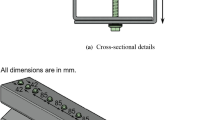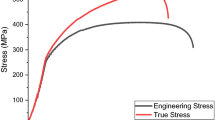Abstract
Closed sections are efficient at producing adequate resistance to high load demands, and their effectiveness is primarily determined by the robustness of the built-up sections' architecture and detailing. The previous studies on cold-formed steel (CFS) sections have identified the importance of hollow flanges in improving the flexural response in beams through their added stability features. In those past studies, it was further observed that lightweight materials like timber, cardboard, etc. have immense potential in enhancing the buckling resistance of compression zones in flexural members. However, the findings on the performance of CFS beams with glass fibre-reinforced polymer (GFRP) planks are missing in the literature. This study presents an experimental programme that focuses on the flexural behaviour of rectangular hollow flanged CFS beams strengthened with GFRP pultruded planks. Three CFS channel sections were used to construct the steel part of each beam model, with GFRP planks as packing material placed in the hollow flange and web region. Self-drilling screws were used to fasten the various elements of each test model. Four test models with simply supported end conditions were tested under monotonic four-point loading. The main objective of this investigation was to analyse the role of GFRP planks in enhancing the buckling resistance of the compression zones of such sections. Material properties of steel were determined before the model testing. Peak loads, load–displacement relationships and failure modes of the models were studied. Also, the strength based on the Indian and American codes was determined for comparison with the test results. The adoption of GFRP packing improved the structural characteristics of rectangular hollow flanges CFS beams significantly. The gains in the flexural capacity, stiffness and strength-to-weight ratio were noted as 83.1%, 43.9% and 48.4%, respectively, when compared with the conventional rectangular flanged CFS built-up beams. Both the American as well as the Indian code over-predicted the moment capacity of the bare CFS built-up beams and underpredicted the same when the GFRP packing was adopted.













Similar content being viewed by others
References
Pirnazar M, Hasheminasab H, Karimi AZ, Ostad-Ali-Askari K, Ghasemi Z, Haeri-Hamedani M, Mohri-Esfahani E, Eslamian S (2018) The evaluation of the usage of the fuzzy algorithms in increasing the accuracy of the extracted land use maps. Int J Glob Environ Issues 17(4):307–321
Ostad-Ali-Askari K, Shayannejad M, Eslamian S, Navabpour B (2018) Comparison of solutions of Saint–Venant equations by characteristics and finite difference methods for unsteady flow analysis in open channel. Int J Hydrol Sci Technol 8(3):229–243
Saeed MK, Alhakeem AA (2021) Selection of optimum structural roof system in Saudi Arabia for a conference hall without interior columns in terms of cost and feasibility. Innov Infrastruct Solut. https://doi.org/10.1007/s41062-020-00377-w
Dar AR, Anbarasu M, Venkatesan M, Dar MA (2021) Wide-flanged CFS built-up columns: comparison of test strengths, numerical validation and design strengths. Innov Infrastruct Solut 6:1–10
Yu J, Becquea J, Hajirasoulihaa I, Mojtabaei SM, Lim JBP (2018) Development of optimum cold-formed steel sections for maximum energy dissipation in uniaxial bending. Eng Struct 161:55–67
Sani MSHM, Muftah F, Ismail MI (2018) Testing and analysis of cold-formed steel channel section with notch. Int J Geomate 14(43):42–49
Siahaan R, Keerthan P, Mahendren M (2018) Section moment capacity design rules for rivet fastened rectangular hollow flange channel beams. Thin Walled Struct 127:781–797
Grenda M, Paczos P (2019) Experimental and numerical study of local stability of non-standard thin-walled channel beams. J Theor Appl Mech 57(3):549–562
Paczos P, Wasilewicz P (2009) Experimental investigations of buckling of lipped, cold-formed thin-walled beams with I—section. Thin Walled Struct 47:1354–1362
Yang Y, Lui EM (2012) Behavior and design of steel I-beams with inclined stiffeners. Steel Compos Struct 12(3):183–205
Dar MA, Dar AR, Yusuf M, Raju J (2015) Experimental study on innovative sections for cold formed steel beams. Steel Compos Struct 19(6):1599–1610
Dar MA, Subramanian N, Rather AI, Dar A, Lim JBP, Anbarasu M, Roy K (2019) Effect of angle stiffeners on the flexural strength and stiffness of cold-formed steel beams. Steel Compos Struct 33(2):225–243
Dar MA, Subramanian N, Dar AR, Anbarasu M, Lim JB, Mir A (2019) Behaviour of partly stiffened cold-formed steel built-up beams: experimental investigation and numerical validation. Adv Struct Eng 22(1):172–186
Dar MA, Subramanian N, Mir A, Dar AR, Anbaasu M, Lim JBP (2020) Efficient cross-sectional profiling of built up CFS beams for improved flexural performance. Steel Compos Structu 34(3):333–345
Dar MA, Subramanian N, Dar AR, Majid M, Haseeb M, Tahoor M (2019) Structural efficiency of various strengthening schemes for cold-formed steel beams: effect of global imperfections. Steel Compos Struct 30(4):393–403
Divahar R, Joanna PS (2018) Numerical simulation and experimental investigation on static behavior of cold formed steel beam with trapezoidally corrugated web by varying depth-thickness ratio. Asian J Civ Eng 19(2):121–137
Faridmehr I, Osman MH, Tahir MM, Azimi M, Gholami M (2016) Behaviour and design of cold-formed steel C-sections with cover plates under bending. Int J Steel Struct 16(2):587–600
Faridmehr I, Tahir MM, Osman MH, Nejad AF, Hodjati R (2015) An experimental investigation of stiffened cold-formed C-channels in pure bending and primarily shear conditions. Thin Walled Struct 96:39–48
Ghannam M (2019) Bending moment capacity of cold-formed steel built-up beams. Int J Steel Struct 19(2):660–671
Muftah F, Sani MSHM, Kamal MMM (2019) Flexural strength behaviour of bolted built-up cold-formed steel beam with outstand and extended stiffener. Int J Steel Struct 19(3):719–732
Anbarasu M, Dar MA, Ghowsi AF, Dar AR (2021) Flexural behaviour of cover plated CFS built-up beams composed of lipped channels: comparison of test and design strengths. Structures 30:294–304. https://doi.org/10.1016/j.istruc.2020.12.088
Wang L, Young B (2016) Behavior of cold-formed steel built-up sections with intermediate stiffeners under bending. I: Tests and numerical validation. J Struct Eng ASCE. https://doi.org/10.1061/(ASCE)ST.1943-541X.0001428
Anbarasu M (2019) Simulation of flexural behaviour and design of cold-formed steel closed built-up beams composed of two sigma sections for local buckling. Eng Struct 191:549–562
Dar MA, Subramanian N, Anbarasu M, Dar AR, Lim JBP (2018) Structural performance of cold-formed steel composite beams. Steel Compos Struct 27(5):545–554
Dar MA, Subramanian N, Dar DA, Dar AR, Anbarasu M, Lim JBP, Mahjoubi S (2020) Flexural Strength of cold-formed steel built-up composite beams with rectangular compression flanges. Steel Compos Struct 34(2):171–188
IS 1608-2005 (2005) Indian Standard—metallic materials—tensile testing at ambient temperature. Bureau of Indian Standards, New Delhi
AISI S100 (2016) North American specification for the design of cold-formed steel structural members. AISI Standard, Washington, DC
IS 1801 (2010) Code of practice for use of cold formed light gauge steel structural members in general building construction. Bureau of Indian Standards, New Delhi
Author information
Authors and Affiliations
Corresponding author
Ethics declarations
Conflict interest
The author declared no potential conflicts of interest with respect to the research, authorship and/or publication of this article.
Rights and permissions
About this article
Cite this article
Dar, A.R. Effect of GFRP strengthening on the flexural behaviour of cold-formed steel built-up beams. Innov. Infrastruct. Solut. 7, 5 (2022). https://doi.org/10.1007/s41062-021-00608-8
Received:
Accepted:
Published:
DOI: https://doi.org/10.1007/s41062-021-00608-8




